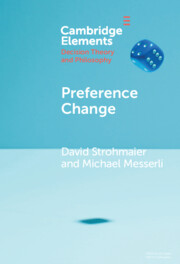377 results
Chapter 7 - Cognitive Control and Social Context of Language Use
-
- Book:
- Cognitive Control along the Language Continuum
- Print publication:
- 27 June 2024, pp 105-116
-
- Chapter
- Export citation
Preface
-
- Book:
- Working with Network Data
- Print publication:
- 13 June 2024, pp xi-xiv
-
- Chapter
- Export citation
Chapter 11 - Identity
- from Part IV - The Project of the Self
-
- Book:
- Transition Expertise and Identity
- Published online:
- 30 May 2024
- Print publication:
- 06 June 2024, pp 233-266
-
- Chapter
- Export citation
Chapter 13 - Conclusion
- from Part IV - The Project of the Self
-
- Book:
- Transition Expertise and Identity
- Published online:
- 30 May 2024
- Print publication:
- 06 June 2024, pp 320-339
-
- Chapter
- Export citation
Diet quality, diet motives, and nutrition literacy of vegans, vegetarians, and semi-vegetarians
-
- Journal:
- Public Health Nutrition / Accepted manuscript
- Published online by Cambridge University Press:
- 03 June 2024, pp. 1-19
-
- Article
-
- You have access
- Open access
- Export citation
11 - Psychological Individual Differences
-
- Book:
- A Practical Guide to Second Language Teaching and Learning
- Published online:
- 03 May 2024
- Print publication:
- 30 May 2024, pp 239-257
-
- Chapter
- Export citation
6 - Motivation, Reward, and Developing Habits
-
- Book:
- The Legal Brain
- Published online:
- 08 May 2024
- Print publication:
- 09 May 2024, pp 69-72
-
- Chapter
- Export citation
The effect of motivation type on intake and nutritional status of vitamin B12, omega-3 fatty acids, iron and nutrition knowledge in individuals following a vegan diet
-
- Journal:
- Proceedings of the Nutrition Society / Volume 83 / Issue OCE1 / April 2024
- Published online by Cambridge University Press:
- 07 May 2024, E136
-
- Article
-
- You have access
- Export citation
Chapter 9 - Can We Get Better at Being Alone?
-
- Book:
- Solitude
- Published online:
- 24 March 2024
- Print publication:
- 18 April 2024, pp 178-201
-
- Chapter
- Export citation
Chapter 3 - What Makes Solitude Great?
-
- Book:
- Solitude
- Published online:
- 24 March 2024
- Print publication:
- 18 April 2024, pp 52-64
-
- Chapter
- Export citation
Impact of financial compensation on enrollment and participation in a remote, mobile-app based research study
-
- Journal:
- Journal of Clinical and Translational Science / Volume 8 / Issue 1 / 2024
- Published online by Cambridge University Press:
- 05 April 2024, e75
-
- Article
-
- You have access
- Open access
- HTML
- Export citation
Five years in: a case study of an Australian early-career secondary school music teacher
-
- Journal:
- British Journal of Music Education , First View
- Published online by Cambridge University Press:
- 03 April 2024, pp. 1-10
-
- Article
-
- You have access
- Open access
- HTML
- Export citation

Solitude
- The Science and Power of Being Alone
-
- Published online:
- 24 March 2024
- Print publication:
- 18 April 2024
Chapter 10 - The Illusion-Motivation Model of Revolution
- from Part IV - Reevaluating Revolutions
-
- Book:
- The Psychology of Revolution
- Published online:
- 07 March 2024
- Print publication:
- 14 March 2024, pp 155-169
-
- Chapter
- Export citation
Chapter 1 - Virtue Theory
- from Part I - Philosophical Resources and Prospects
-
- Book:
- The Science of Virtue
- Published online:
- 11 January 2024
- Print publication:
- 01 February 2024, pp 25-52
-
- Chapter
-
- You have access
- HTML
- Export citation
4 - Strategies Contributing to Success
- from Part II
-
- Book:
- Succeeding and Adult Dyslexia
- Published online:
- 11 January 2024
- Print publication:
- 01 February 2024, pp 89-137
-
- Chapter
- Export citation
Chapter 11 - The Four Components of Virtue
- from Part III - Organizing Virtue Research with the STRIVE-4 Model
-
- Book:
- The Science of Virtue
- Published online:
- 11 January 2024
- Print publication:
- 01 February 2024, pp 266-288
-
- Chapter
- Export citation
2 - Interpretations and Fields of Application
- from Part I - The Colours of Power
-
- Book:
- Power and Inequality
- Published online:
- 04 January 2024
- Print publication:
- 18 January 2024, pp 11-26
-
- Chapter
- Export citation
Learning needs of junior doctors in otolaryngology: a qualitative study
-
- Journal:
- The Journal of Laryngology & Otology / Volume 138 / Issue 6 / June 2024
- Published online by Cambridge University Press:
- 17 January 2024, pp. 592-600
- Print publication:
- June 2024
-
- Article
- Export citation

Preference Change
-
- Published online:
- 11 January 2024
- Print publication:
- 01 February 2024
-
- Element
-
- You have access
- Open access
- HTML
- Export citation



